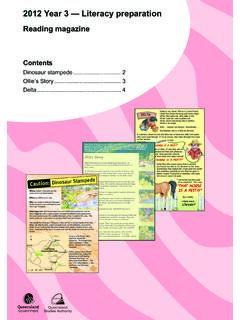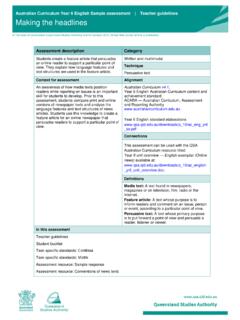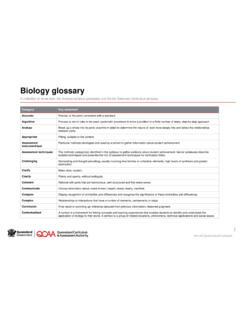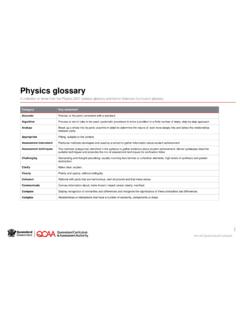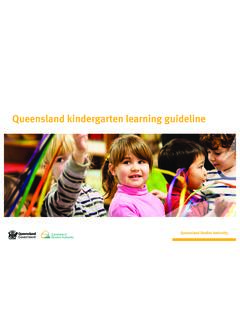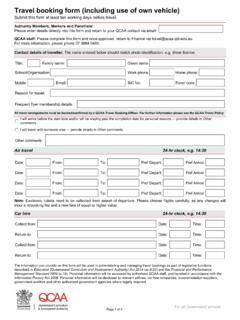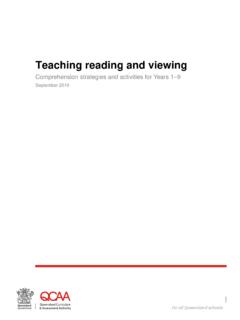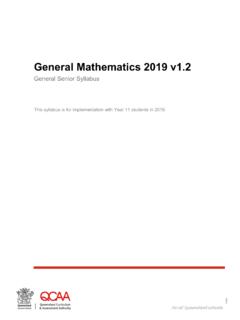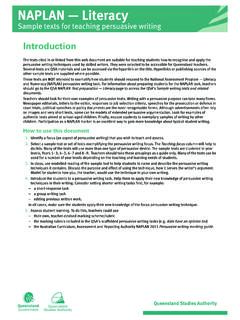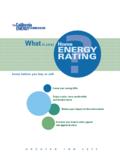Transcription of Australian Curriculum Year 9 Science sample assessment ...
1 14980 The State of Queensland (Queensland Curriculum and assessment Authority) and its licensors 2014. All web links correct at time of publication. assessment description Category Students use the particle model and the relationships between energy, power, voltage, current and resistance to demonstrate their understanding of energy transfer in electric circuits. They investigate factors that affect the transfer of energy. Written Technique Supervised assessment Experimental investigation Context for assessment Alignment Electric appliances containing heating elements are common in students daily lives.
2 Heating elements change electrical energy into heat energy and an understanding of electrical energy, power and Ohm s law can be used to explain how heating elements work. Heating elements are made of metals with high resistance, such as nichrome wire, and the size of the wire affects the amount of electrical energy flowing in the wire and therefore the heat energy produced. The practical investigation of this topic and communication of findings provide opportunities for students to develop skills used by the scientific community. Australian Curriculum , Year 9 Science Australian Curriculum content and achievement standard ACARA Australian Curriculum , assessment and Reporting Authority Year 9 Science standard elaborations available at: Connections This assessment can be used with the QCAA Australian Curriculum resource titled Year 9 plan Australian Curriculum : Science exemplar available at.
3 Downloads/p_10 Definitions See the Australian Curriculum glossary for technical terms used in this assessment In this assessment assessment materials Teacher guidelines Student booklet Task-specific standards continua Task-specific standards matrix sample response assessment resource Explaining resistance in terms of the particle model assessment resource Scientific inquiry process Section 2: variable power supply (power pack) ammeter and voltmeter or 2 multimeters switch 6 connecting wires, with alligator clips heatproof mat 50 cm and 100 cm lengths of 20 swg ( mm diameter) and 26 swg ( mm diameter)
4 Nichrome wire Australian Curriculum Year 9 Science sample assessment Teacher guidelines Electric kettles Teacher guidelines Identify Curriculum Content descriptions to be taught Science Understanding Science as a Human Endeavour Science Inquiry Skills Physical sciences Energy transfer through different mediums can be explained using wave and particle models ACSSU182 Use and influence of Science People can use scientific knowledge to evaluate whether they should accept claims, explanations or predictions ACSHE160 Planning and conducting Plan, select and use appropriate investigation methods, including field work and laboratory experimentation, to collect reliable data.
5 Assess risk and address ethical issues associated with these methods ACSIS165 Select and use appropriate equipment, including digital technologies, to systematically and accurately collect and record data ACSIS166 Processing and analysing data and information Analyse patterns and trends in data, including describing relationships between variables and identifying inconsistencies ACSIS169 Use knowledge of scientific concepts to draw conclusions that are consistent with evidence ACSIS170 Evaluating Evaluate conclusions, including identifying sources of uncertainty and possible alternative explanations, and describe specific ways to improve the quality of the data ACSIS171 Communicating Communicate scientific ideas and information for a particular purpose, including constructing evidence-based arguments and using appropriate scientific language, conventions and representations ACSIS174 Australian Curriculum Year 9 Science Electric kettles Teacher guidelines General capabilities (GCs) and cross- Curriculum priorities (CCPs)
6 This assessment may provide opportunities to engage with the following GCs and CCPs. Refer also to the Resources tab on the Year 7 Science Curriculum and assessment page: Literacy Numeracy ICT capability Critical and creative thinking Achievement standard This assessment provides opportunities for students to demonstrate the following highlighted aspects. By the end of Year 9, students explain chemical processes and natural radioactivity in terms of atoms and energy transfers and describe examples of important chemical reactions. They describe models of energy transfer and apply these to explain phenomena.
7 They explain global features and events in terms of geological processes and timescales. They analyse how biological systems function and respond to external changes with reference to interdependencies, energy transfers and flows of matter. They describe social and technological factors that have influenced scientific developments and predict how future applications of Science and technology may affect people s lives. Students design questions that can be investigated using a range of inquiry skills. They design methods that include the control and accurate measurement of variables and systematic collection of data and describe how they considered ethics and safety.
8 They analyse trends in data, identify relationships between variables and reveal inconsistencies in results. They analyse their methods and the quality of their data, and explain specific actions to improve the quality of their evidence. They evaluate others methods and explanations from a scientific perspective and use appropriate language and representations when communicating their findings and ideas to specific audiences. Source: ACARA, The Australian Curriculum , Sequence learning Suggested learning experiences This assessment leads on from the learning experiences outlined in the QCAA s Year 9 Science Year level plan.
9 The knowledge, understanding and skills in the Year level plan will prepare students to engage in this assessment : See Year 9 plan Science exemplar Adjustments for needs of learners To make adjustments, teachers refer to learning area content aligned to the child s chronological age, personalise learning by emphasising alternate levels of content, general capabilities or cross- Curriculum priorities in relation to the chronological age learning area content. The emphasis placed on each area is informed by the student s current level of learning and their strengths, goals and interests.
10 Advice on the process of Curriculum adjustment for all students and in particular for those with disability, gifted and talented or for whom English is an additional language or dialect are addressed in Australian Curriculum Student Diversity materials. For information to support students with diverse learning needs, see: Queensland Curriculum and assessment A uthority materials for supporting children with diverse learning needs Australian Curriculum Student Diversity The Melbourne Declaration on Educational Goals for Young Australians Australian Curriculum Year 9 Science Electric kettles Teacher guidelines The Disability Standards for Education Resources Education Queensland Classroom activity risk management guidelines Develop assessment Preparing for the assessment Learning experiences in preparation for the assessment could include.
